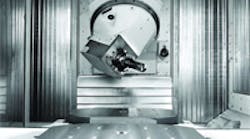Shops that work with large or difficult-to-handle parts benefit when being able to perform 5-sided machining in single setups in job volumes that range from prototype to production levels on one machine.
Unfortunately, not all machining centers can meet this need.
Light-duty machining centers easily handle complete 5-sided machining on aluminum parts, and large boring mills can cut five sides of large parts, but the process usually requires more than one setup. In addition, many universal or C-head machining centers are large-format machines that are designed for ship building and big power-generation parts.
The perfect machine for 5-sided cutting large parts in single setups, according to Heller Machine Tools, is a universal horizontal spindle-type machining center that is beefy enough to handle all operations on, for example, a cast iron engine block in a single setup. However, the machine also must be scaled for machining more than 90 percent of the parts that today’s horizontal machining centers are used for.
Heller says its MCH-C machines, which are available in three different sizes, fit the bill.
Many shops machining medical, aerospace, power generation and general jobshop parts have discovered Heller’s MCH-C machines. The machines take shops from prototype machining and product development to short runs and low production. Then, as product demand increases, the machines can be switched to producing high-volume jobs to 350,000 parts annually as part of a flexible manufacturing system.
It’s this ramp-up strategy that Heller said conserves capital cost without compromising production flexibility for future assignments. Heller said its customers rely on the machines’ combination of flexibility, capability, time savings and machining quality as they respond to demand for sophisticated products.
The company said several features contribute to the MCH-C machines’ abilities to perform machining that ranges from prototype to mass production. The features include a highly developed C-axis head, high spindle torque and rigid construction. AC-driven preloaded ballscrews deliver thrusts in each machine axis equal to 1,500/1,750 daN or 3,300/3,850 lb.
Machine heads and spindles are designed for efficient and high-power machining. Inside the compact universal head, the spindle rotates around an axis that tilts 45 degrees from the work plane formed by the Y vertical axis and the Z table-feed axes, to reach positions between 0 degrees horizontal and 90 degrees vertical. Heller said that allows complete use of the work area. A 0.001-degreeresolution direct measurement rotary scale is designed to ensure accurate positioning of the rotating head.
A two-speed gearbox drives the machine’s precision spindle. The high range is direct drive, and the low range features a 1:4 reduction gear ratio. Both of these features make it possible for the machine to cut all types of material efficiently.
The spindle motor generates a maximum power of 43 kW/58 hp (40 percent duty cycle) standard and a torque of 820 Nm/606 ft-lb (40 percent duty cycle) standard – power and torque ratings that are considered high for universal machining centers. Machine power and torque is combined with ISO 50 or HSK 100 toolholders and spindle speeds up to 8,000 rpm for heavy cutting.
The cartridge-style spindle is designed so that it can be pulled for maintenance or repair without having to remove the C head, and Heller lubricates the spindle bearings with air-oil, and has designed a refrigerated cooling loop to stabilize the spindle thermally.
The basic modules of the MCH-C machines consist of a family of three different size single-piece cast iron bases, thermosymmetrical hollow-core cast iron columns, quick-acting pallet exchangers and standardized tool change systems. Spindles are the same on all three models, and pallet sizes range from 630 mm by 630 mm to 800 mm by 1,000 mm. Table load capacities range from 1,760 lb to 5,500 lb. Chaintype tool magazines store 50 to 100 tools, and the rack-type magazines have capacities to 405 tools.
Heller said its precision linear guideways minimize maintenance, dampen vibration and provide higher speeds, quicker accelerations and longer life than conventional box-type ways. The stick/slip ratio of linear guideways, combined with direct linear scales, yield positioning tolerances to 7 microns.
MCH-C machines are equipped with Siemens Sinumerik 840D/ DE CNCs that include software applications for machining complex shapes and surfaces, such as dies, cams and other surfaces requiring multi-axis interpolation.
Coupled with Siemens Simodrive 611D digital drives, the multiaxis programming of the 5-axis machining center is simplified because the vector conversion between workpiece coordinates and the absolute coordinates — the machine axes reference system — are solved automatically, starting from the parameters in the work program.
Similarly, the CNC sets the direction of the revolving axes — B table and C head — according to the angle needed, and interpolates the linear axes along the tool path with continuous speed.
The MCH-C machines load manually or automatically at setting stations. FMS linkage is an option, and integrated rotary or linear pallet pools and pallet systems allow shops to upgrade the MCH-C machines to flexible machining cells.








